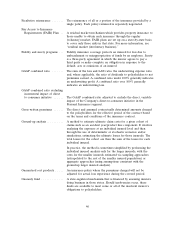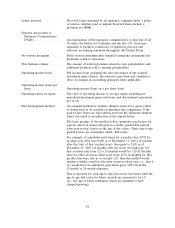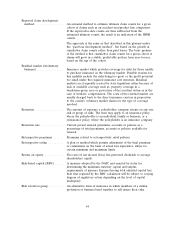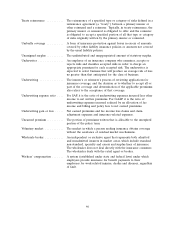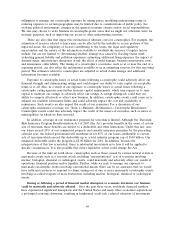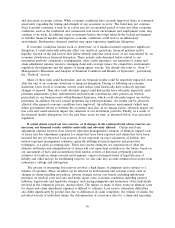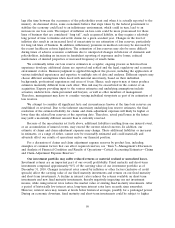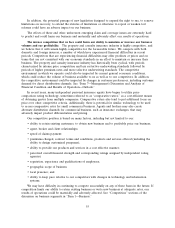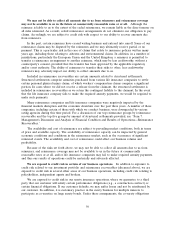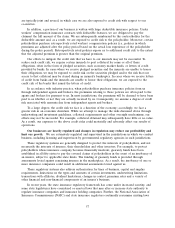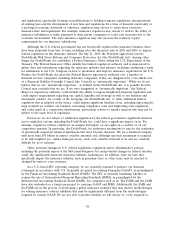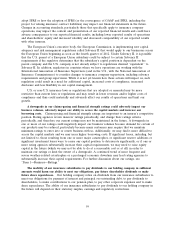Travelers 2010 Annual Report Download - page 61
Download and view the complete annual report
Please find page 61 of the 2010 Travelers annual report below. You can navigate through the pages in the report by either clicking on the pages listed below, or by using the keyword search tool below to find specific information within the annual report.and decreased economic activity. While economic conditions have recently improved, there is continued
uncertainty regarding the timing and strength of any economic recovery. The trend may not continue.
Even if growth continues, it may be at a slow rate for an extended period of time and other economic
conditions, such as the residential and commercial real estate environment and employment rates, may
continue to be weak. In addition, some economists believe that steps taken by the federal government
to stabilize financial markets and improve economic conditions could lead to an inflationary
environment. Furthermore, financial markets may again experience significant disruption.
If economic conditions remain weak or deteriorate, or if financial markets experience significant
disruption, it could materially adversely affect our results of operations, financial position and/or
liquidity. Several of the risk factors that follow identify risks that result from, or are exacerbated by, an
economic slowdown or financial disruption. These include risks discussed below related to our
investment portfolio, reinsurance arrangements, other credit exposures, our estimates of claims and
claim adjustment expense reserves, emerging claim and coverage issues, the competitive environment,
regulatory developments and the impact of rating agency actions. You should also refer to ‘‘Item 7—
Management’s Discussion and Analysis of Financial Condition and Results of Operation’’, particularly
the ‘‘Outlook’’ section.
Many of these risks could materialize, and our financial results could be negatively impacted, even
after the end of an economic downturn or financial disruption. During or following an economic
downturn, lower levels of economic activity could reduce (and historically have reduced) exposure
changes at renewal. They also could adversely impact (and historically have adversely impacted) audit
premium adjustments, policy endorsements and mid-term cancellations after policies are written,
particularly in our business units within Business Insurance, which could adversely impact our written
premiums. In addition, because earned premiums lag written premiums, our results can be adversely
affected after general economic conditions have improved. An inflationary environment (which may
follow government efforts to stabilize the economy) may also, as we discuss below, adversely impact our
loss costs and could adversely impact the valuation of our investment portfolio. Finally, as a result of
the financial market disruptions over the past three years, we may, as discussed below, face increased
regulation.
If actual claims exceed our loss reserves, or if changes in the estimated level of loss reserves are
necessary, our financial results could be materially and adversely affected. Claims and claim
adjustment expense reserves (loss reserves) represent management’s estimate of ultimate unpaid costs
of losses and loss adjustment expenses for claims that have been reported and claims that have been
incurred but not yet reported. Loss reserves do not represent an exact calculation of liability, but
instead represent management estimates, generally utilizing actuarial expertise and projection
techniques, at a given accounting date. These loss reserve estimates are expectations of what the
ultimate settlement and administration of claims will cost upon final resolution in the future, based on
our assessment of facts and circumstances then known, reviews of historical settlement patterns,
estimates of trends in claims severity and frequency, expected interpretations of legal theories of
liability and other factors. In establishing reserves, we also take into account estimated recoveries from
reinsurance, salvage and subrogation.
The process of estimating loss reserves involves a high degree of judgment and is subject to a
number of variables. These variables can be affected by both internal and external events, such as:
changes in claims handling procedures; adverse changes in loss cost trends, including inflationary
pressures on medical costs and auto and home repair costs; economic conditions including general
inflation; legal trends and legislative changes; and varying judgments and viewpoints of the individuals
involved in the estimation process, among others. The impact of many of these items on ultimate costs
for claims and claim adjustment expenses is difficult to estimate. Loss reserve estimation difficulties
also differ significantly by product line due to differences in claim complexity, the volume of claims, the
potential severity of individual claims, the determination of occurrence date for a claim and reporting
49



